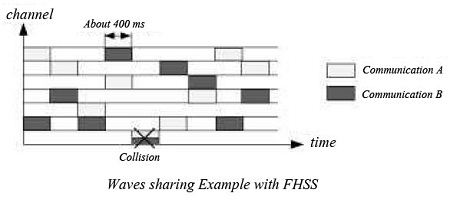The FHSS (Frequency Hopping Spread Spectrum) was invented and patented in 1942 by the actress Hedy Lamarr and pianist George Antheil, which were quite versatile! The principle of FHSS is quite simple: a wide frequency band is divided into multiple channels and communications are jumping (hopping) sequentially from one channel to another in a sequence and a rate agreed to advance between the transmitter and the receiver.
It is difficult to intercept communications if we do not know the sequence chosen, so it was much appreciated by the US military who used for radio guide torpedoes without the enemy to intercept or jam the signal. In the case of 802.11, this function is (unfortunately) not operating because the channel sequences used are not secret.
FHSS also provides significant resistance to interference or even volunteers for interference channels where the noise is too large can simply be avoided. However, 802.11 FHSS does not exploit this ability, unlike Bluetooth and Home RF are two technologies Wireless using FHSS modulation.
A final advantage is that many of the FHSS communications may held simultaneously on the same frequency band as long as they use channel sequences not colliding with each other. For example, communication could use the trivial sequence 1,2,3,1,2,3,1,2,3 while … another communication would have the following sequence: 2,3,1,2,3,1,2,3,1 … so at no time did the two communications using the same channel.
In return, each communication has a relatively low rate since operates only one fairly narrow channel at a time.
In the first version of 802.11, the frequency range from 2400 MHz 2483.5 MHz was cut for the FHSS channels of 1 MHz wide each.

In most countries, the channels 2-80 are allowed (from 2401 MHz to 2480 MHz). Within each channel, modulation Gaussian FSK with two states (2GFSK) is used and allows a flow rate of 1 Mb/s. Using 4GFSK modulation (GFSK four states, or 2 bits per symbol) you can reach 2 Mb / s. Using GFSK as a modulation underlying FHSS avoids interference between neighboring channels, allowing multiple users to communicate in FHSS same time without interfering.
802.11 has defined a dynamic rate adaptation mechanism Depending on the signal / noise ratio: When high, the modulation used is 4GFSK to 2 Mb / s, otherwise the 802.11 adapts automatically and “down” in 2GFSK 1 Mb/s.
 Dinesh Thakur holds an B.C.A, MCDBA, MCSD certifications. Dinesh authors the hugely popular
Dinesh Thakur holds an B.C.A, MCDBA, MCSD certifications. Dinesh authors the hugely popular